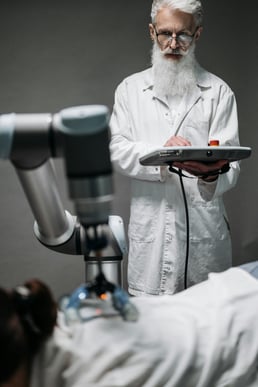Robotic Surgery: Reality or Science Fiction?
Robotic Surgery: Reality or Science Fiction? Explore how robotic systems are transforming surgeries and improving patient recovery.
Health Is Life
1/24/20251 min read
The use of robotic systems in surgeries has rapidly evolved, merging science fiction with reality. These innovations promise increased precision, reduced recovery time, and better outcomes for patients. But how far have we truly come? Let’s dive into the current advancements and challenges in robotic surgery.
Advantages of Robotic Surgery
Enhanced Precision:
Robotic arms can perform intricate movements with incredible accuracy, minimizing tissue damage.
Reduced Invasiveness:
Many procedures are now minimally invasive, leading to smaller incisions and faster recovery times.
Better Visualization:
High-definition cameras and 3D imaging provide surgeons with detailed views of the surgical site.
Reduced Surgeon Fatigue:
Robotic systems alleviate physical strain on surgeons, improving performance in lengthy procedures.
Challenges and Limitations
High Costs:
Robotic surgical systems are expensive to acquire and maintain, limiting their availability.
Learning Curve:
Surgeons require extensive training to master these advanced systems.
Risk of Technical Failures:
Although rare, system malfunctions can pose risks during critical moments.
Popular Robotic Surgery Systems
da Vinci Surgical System: The most widely used system, enabling procedures in urology, gynecology, and more.
MAKO: Focuses on orthopedic surgeries, such as knee and hip replacements.
ROSATM: Specialized in spinal surgeries with high precision.
Impact on Patient Recovery
Shorter Hospital Stays:
Patients often recover faster due to less invasive techniques.
Reduced Pain and Scarring:
Smaller incisions result in less post-operative discomfort and minimal scarring.
Faster Return to Daily Life:
Many patients resume normal activities sooner compared to traditional surgery.
Robotic surgery is no longer a distant dream but a reality reshaping modern medicine. While challenges remain, its potential to revolutionize healthcare is undeniable.
Scientific Evidence:
Precision and Outcomes: A study in the Journal of Robotic Surgery (2021) found that robotic-assisted procedures reduced complication rates and improved surgical precision compared to traditional methods.
Patient Recovery: Research published in The Lancet (2020) showed that patients undergoing robotic surgeries experienced faster recovery and reduced hospital stays.
Cost Analysis: A 2022 report in Health Economics Review highlighted the high upfront costs of robotic systems but noted their long-term benefits in reducing overall healthcare expenses.
Surgeon Performance: According to the Annals of Surgery (2021), robotic systems significantly lowered surgeon fatigue during complex procedures, improving overall performance.


